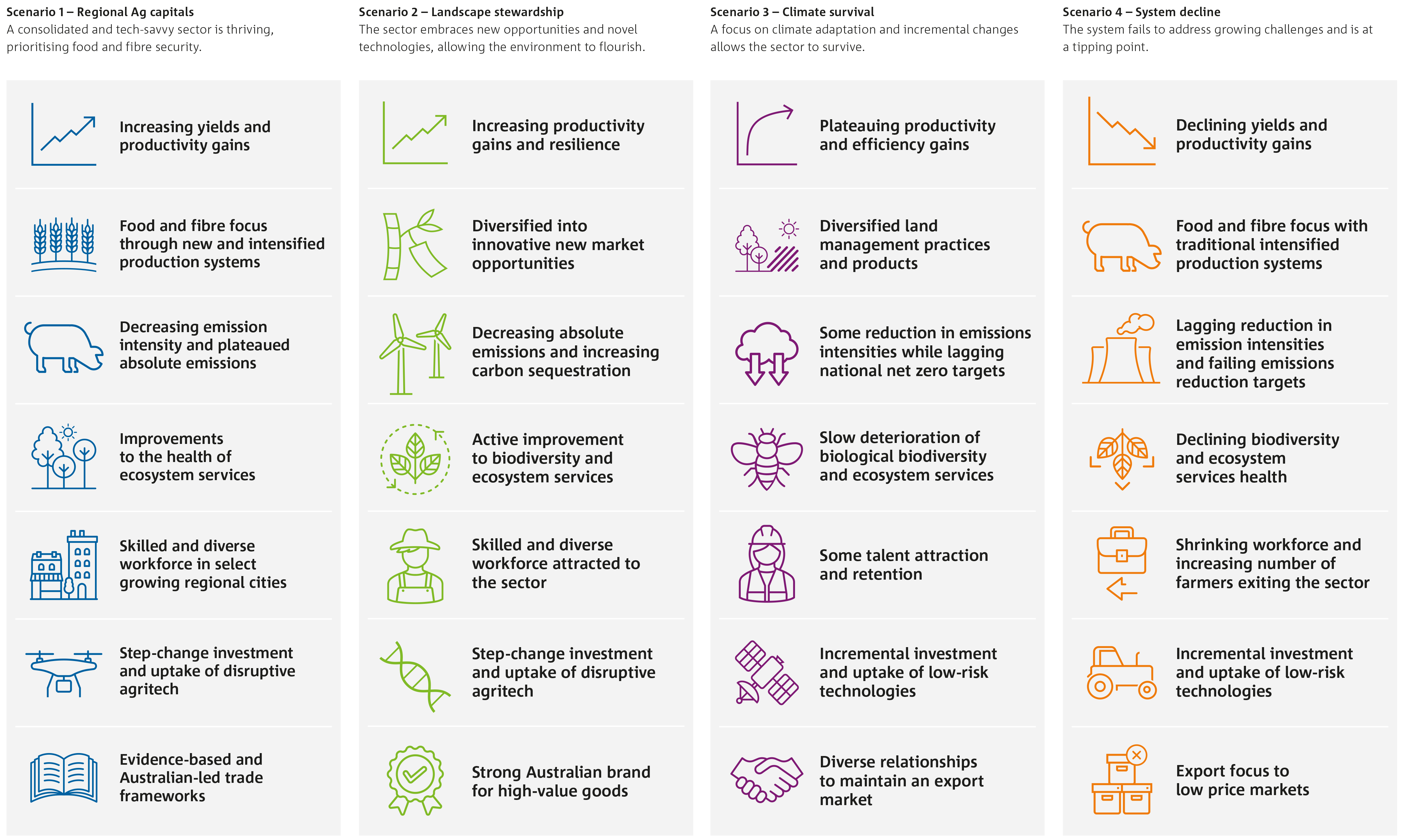What could productive, resilient, and sustainable farming systems look like in Australia by 2050?
This is the question the Ag2050 Scenarios Report, spanning land-based farming, forestry, aquaculture and fisheries, aims to answer through exploring the significant trends, risks and opportunities facing Australian agriculture.
With growing threats of climate change, net zero mandates, rising geopolitical uncertainty, an ageing workforce, and changing consumer preferences and market access, Australian agriculture faces significant long-term threats to farm productivity, resilience and sustainability.
To meet the challenges and fulfil the sustainability, productivity, and profitability needs of 2050, Australia will need to accelerate the transformation of its current farming systems.
Delivered through consultation and co-design with over 100 industry stakeholders, this report presents four evidence-based, plausible scenarios for what Australian farming systems could look like in 2050.
The report aims to motivate discussions between industry, researchers and policymakers, fostering strategic coordination within the Australian agriculture innovation system, to productively address cross-sectoral challenges and opportunities.
Download the report
- Executive summary
- Executive summary, accessible text only
- Full report
- Full report, accessible text only
Four future scenarios
The report presents four evidence-based future scenarios of what Australian farming systems could look like by 2050. While some may have more desirable elements than others, it's crucial to recognise that no single scenario is preferred, and each scenario entails trade-offs. The scenarios include:
- Regional Ag capitals - a consolidated and technologically advanced sector, thriving and prioritising food and fibre production.
- Landscape stewardship - a forward-thinking sector embracing new opportunities and novel technologies, allowing the environment to flourish.
- Climate survival - a sector focused on climate adaptation and surviving through incremental changes.
- System decline - a stressed sector failing to address growing challenges and reaching a tipping point.

What next?
How Australia responds to trends and challenges will determine, in large part, its future outcomes. To meet the challenges and fulfil the sustainability, productivity, and profitability needs of 2050, Australia will need to accelerate the transformation of its current farming systems.
This report aims to motivate discussions between industry, researchers and policymakers, fostering strategic coordination within the Australian agriculture innovation system, to productively address cross-sectoral challenges and opportunities.
Ag2050 Program
The Ag2050 Scenarios Report is the first phase of CSIRO's Ag2050 program, a disruptive multi-year initiative aimed at identifying interventions, innovations, and support necessary for a productive, resilient, and sustainable future for Australian agriculture.
Learn more about the Ag2050 program.
The Ag2050 Scenarios Report was led by CSIRO with financial and in-kind support from the Australian Department of Agriculture, Fisheries and Forestry (DAFF).
What could productive, resilient, and sustainable farming systems look like in Australia by 2050?
This is the question the Ag2050 Scenarios Report, spanning land-based farming, forestry, aquaculture and fisheries, aims to answer through exploring the significant trends, risks and opportunities facing Australian agriculture.
With growing threats of climate change, net zero mandates, rising geopolitical uncertainty, an ageing workforce, and changing consumer preferences and market access, Australian agriculture faces significant long-term threats to farm productivity, resilience and sustainability.
To meet the challenges and fulfil the sustainability, productivity, and profitability needs of 2050, Australia will need to accelerate the transformation of its current farming systems.
Delivered through consultation and co-design with over 100 industry stakeholders, this report presents four evidence-based, plausible scenarios for what Australian farming systems could look like in 2050.
The report aims to motivate discussions between industry, researchers and policymakers, fostering strategic coordination within the Australian agriculture innovation system, to productively address cross-sectoral challenges and opportunities.
Download the report
- Executive summary PDF (1 MB)
- Executive summary, accessible text only TXT (20 KB)
- Full report PDF (7 MB)
- Full report, accessible text only TXT (245 KB)
Four future scenarios
The report presents four evidence-based future scenarios of what Australian farming systems could look like by 2050. While some may have more desirable elements than others, it's crucial to recognise that no single scenario is preferred, and each scenario entails trade-offs. The scenarios include:
- Regional Ag capitals - a consolidated and technologically advanced sector, thriving and prioritising food and fibre production.
- Landscape stewardship - a forward-thinking sector embracing new opportunities and novel technologies, allowing the environment to flourish.
- Climate survival - a sector focused on climate adaptation and surviving through incremental changes.
- System decline - a stressed sector failing to address growing challenges and reaching a tipping point.
Scenario 1 Regional Ag capitals
A consolidated and tech-savvy sector is thriving,
prioritising food and fibre security.
Scenario 2 Landscape stewardship
The sector embraces new opportunities and novel technologies, allowing the environment to flourish.
Scenario 3 Climate survival
A focus on climate adaptation and incremental changes allows the sector to survive.
Scenario 4 System decline
The system fails to address growing challenges and is at a tipping point.
What next?
How Australia responds to trends and challenges will determine, in large part, its future outcomes. To meet the challenges and fulfil the sustainability, productivity, and profitability needs of 2050, Australia will need to accelerate the transformation of its current farming systems.
This report aims to motivate discussions between industry, researchers and policymakers, fostering strategic coordination within the Australian agriculture innovation system, to productively address cross-sectoral challenges and opportunities.
Ag2050 Program
The Ag2050 Scenarios Report is the first phase of CSIRO's Ag2050 program, a disruptive multi-year initiative aimed at identifying interventions, innovations, and support necessary for a productive, resilient, and sustainable future for Australian agriculture.
Learn more about the Ag2050 program.
The Ag2050 Scenarios Report was led by CSIRO with financial and in-kind support from the Australian Department of Agriculture, Fisheries and Forestry (DAFF).
